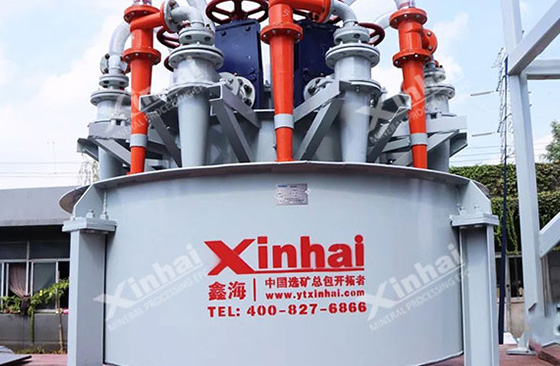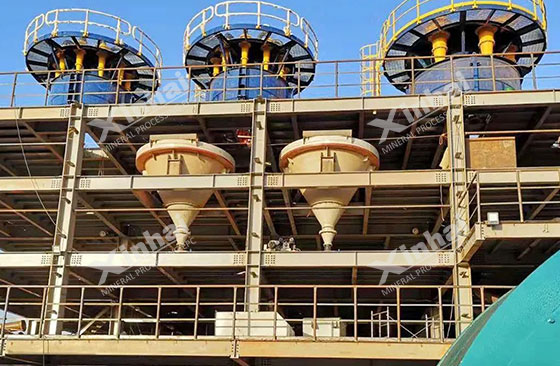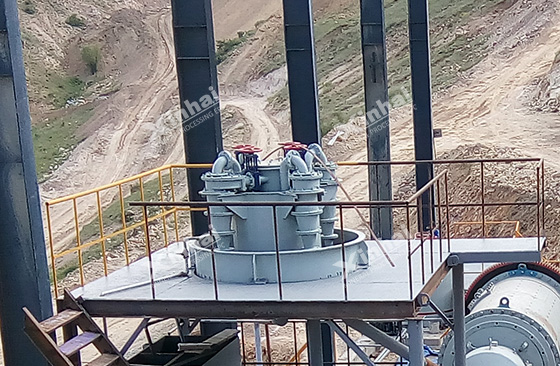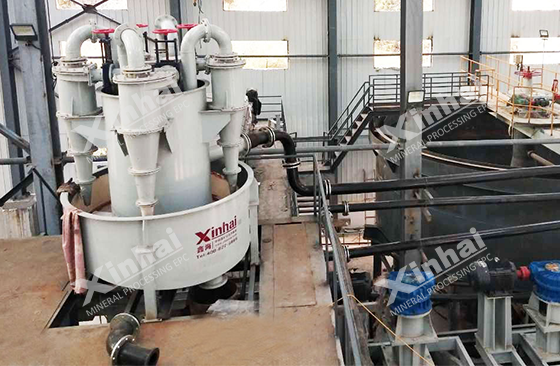Hydrocyclone is a solid-liquid separation equipment commonly used in mineral processing, which mainly uses centrifugal force to classify and separate materials. With its efficient separation performance, hydrocyclone plays a vital role in the mineral processing process, especially in the treatment of fine-grained materials. Hydrocyclone can not only be used for ore pretreatment and classification, but also for the recovery of ore tailings. With the increasing demand for fine-grained mineral separation in the mining industry, the application of hydrocyclone is more extensive. This article will explore the application of hydrocyclone in mineral separation, influencing factors, etc., to help you better understand the working mode of hydrocyclone.
Use the table of contents below to navigate through the guide:
01Working principle of hydrocyclone

The basic working principle of hydrocyclone is based on fluid dynamics and centrifugal force. When the mixed material enters the feed port of the cyclone at a certain pressure, the material will flow along a rotating path inside the cyclone. Under the action of centrifugal force, the heavier mineral particles will be thrown to the outer wall of the cyclone, while the relatively light materials will rise along the center of the cyclone. The separated medium minerals will be discharged from the overflow port at the bottom of the cyclone, and the light minerals will be discharged from the overflow port at the top of the cyclone. Through this classification method, the separation of mineral particles of different densities and particle sizes can be achieved. When the cyclone is working, the feed concentration, flow rate, particle density difference, etc. will affect the working effect of the cyclone.
02Application of hydrocyclone in mineral processing

Due to its advantages in operation and low energy consumption, hydrocyclones are widely used in mineral processing plants, and their application functions are different.
1. Ore pretreatment and classification
After ore crushing, the application of hydrocyclones can separate coarse and fine materials in the ore, providing convenience for subsequent mineral processing. In the primary classification process of ore, hydrocyclones can effectively improve the sorting efficiency and reduce the workload of subsequent equipment.
2. Separation of fine-grained minerals
The separation of fine-grained minerals has always been a difficult problem in the mineral sorting process. When such materials are treated by traditional gravity sorting, flotation and other processes, the separation effect is not good. When the material particle size reaches the micron level, the separation efficiency decreases significantly. The centrifugal force generated during the operation of the hydrocyclone can effectively treat fine-grained minerals, and excellent separation effects can be obtained when the ore particle size is small. By optimizing the feed pressure and cyclone design, the hydrocyclone can finely classify fine-grained minerals to meet the requirements of efficient sorting.
3. Tailings recovery and resource utilization
A large amount of tailings will be generated during the beneficiation process. Since the tailings contain a certain amount of valuable minerals, the use of hydrocyclones can effectively recover the valuable minerals and improve the tailings recovery rate, thereby realizing the reuse of tailings resources. By improving the mineral recovery rate in the tailings, it can not only reduce the impact on the surrounding environment, but also improve the overall benefits of mining production.
03Advantages and Disadvantages of Hydrocyclone

Advantages:
1. High efficiency: It can complete material separation in a short time, with high separation efficiency and large processing capacity.
2. Energy saving: Compared with other solid-liquid separation equipment, hydrocyclone has lower energy consumption and lower operating cost.
3. Easy operation: Because the hydrocyclone has a simple structure and is easy to operate and maintain, it must have complex technical support.
4. Equipment durability: The design of the hydrocyclone generally uses wear-resistant rubber materials, which can ensure the long-term use of the equipment.
Disadvantages:
1. Limited separation accuracy: The hydrocyclone has poor sorting effect for materials with similar particle sizes, and when the particle fineness is high, the separation effect will also be limited.
2. High requirements for particle morphology: For small or irregularly shaped mineral particles, the separation efficiency of the hydrocyclone will be reduced.
3. Feed concentration and flow rate: Too high or too low concentration of the material will affect the separation effect of the hydrocyclone. By accurately controlling the feed concentration and flow rate, the working effect of the hydrocyclone can be optimized.

The above is a brief introduction to the working principle, mineral processing application, advantages and disadvantages of hydrocyclone. In actual production, hydrocyclones have been widely used in many mineral processing plants, showing the advantages of high efficiency, energy saving and simple operation during the application process. With the continuous development of technology, the working performance of hydrocyclones will be further improved, and they will be more widely used in the mining industry in the future.


 marketing@ytxinhai.com
marketing@ytxinhai.com  0086 13810327080
0086 13810327080 






































































































 CHAT
CHAT MESSAGE
MESSAGE




